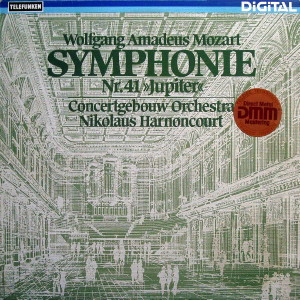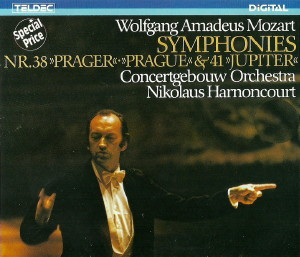 |
1 LP -
6.42486 AG - (p) 1983
|
 |
| 2 CD -
8.48219 ZL - (c) 1985 |
|
| Wolfgang Amadeus
Mozart (1756-1791) |
|
|
|
|
|
|
|
| Symphonie Nr. 41 C-dur,
KV 551 "Jupiter" |
|
41' 22" |
|
- Allegro vivace
|
13' 13" |
|
A1 |
- Andante cantabile
|
11' 40" |
|
A2 |
- Menuetto: Allegretto
|
5' 17" |
|
B1 |
- Molto Allegro
|
11' 12" |
|
B2 |
|
|
|
|
| CONCERTGEBOUW ORCHESTRA,
AMSTERDAM |
|
| Nikolaus
Harnoncourt, Dirigent |
|
|
Luogo
e data di registrazione
|
Concertgebouw,
Amsterdam (Olanda) - marzo 1982
|
|
Registrazione
live / studio
|
| studio |
Producer
/ Engineer
|
-
|
Prima Edizione CD
|
| Teldec
- 8.48219 ZL - (2 cd) - 38' 15" + 41'
24" - (c) 1985 - DDD |
Prima
Edizione LP
|
Telefunken - 6.42486
AZ - (1 lp) - 41'
24"
- (p) 1983 -
Digital
|
|
|
Notes
|
Mozart's last three
symphonies (no. 39 in E flat major,
K. 543, no. 40 in G
minor. K. 550
and no. 41 in C
major. K. 551) were all written in the summer of 1788 in an apartment
tn a suburb of Vienna (now Währingerstraße 16)
wich the Mozart family
had fled to after
an argument with their previous
landlord and in dire financial
straits. Mozart attempted to make
the best of this humiliating, social
comedown: "I
have greater leisure to work now
since I am not
troubled by so many visitors... the
new lodgings are also cheaper and
more pleasant in spring, summer and
autumn because there is a garden." The three
symphonies, which were clearly
conceived as a cycle, were presumably
intended for subscription concerts:
these, however,
failed to materialize either in the
winter of 1788/89 or in successive
years. With the possible exception
of no. 40, Mozart's
last three symphonies were never
perforated during his lifetime.
The C major symphony - the
designation "Jupiter" is
contemporary, probably coming from
the London concert organizer Salomon
- is the largest in scale and most
splendid of the three, and also, in
the finale at any rate, the most
sophisticated. The work’s concept
could be paraphrased
as the reconciliation of opposites:
the traditionally festive character
of C major is in no way absent, yet
the clear skies are periodically
clouded by sudden passages in the
minor and by a chromaticism
that affects almost all the thematic
material. Contrapuntal and
homophonic writing are blended with
an inventiveness unparalleled even
in Mozart`s work, Familiar forms are
overlaid in the Andante and the Finale, and to a
fewer extent in the Minuet, by sonata
models. The opposites or antithtmes
are brought out in detail; the two
contrasting motifs that open the
first movement represent not only
two emotions, but also the solemn
rhythms of the French overture
tradition and the
"singing" allegro that Mozart was so
fond of (the
overture to ‘La Clemenza di Tito' was to link
up to this constellation). But the
singing motif and its emotion also
form the basis - at first concealed,
then clearly discernible - of the
second subject, which in turn consists of two
(less harshly) contrasting motifs. In
the same way, the second motif of this subject
forms the emotional bridge to the
final group, which links up with an
aria Mozart composed
in May 1788 as an
intermerzo for an opera by Pasquale
Anfossi ("Un
bacio di mano", K. 541) and thus
conjures up the world of opera
buffa. The development corresponds
to the thinking in terms of
contrasting and at the same time
complementary pairs of sections -
first. the final group is developed
from E flat major through G minor
and F rninor to E major, then the
main subject leads back to the
repeat.
The symphony's genial, here mild
basic tone, but also the abrupt
minor interludes, likewise mark the
Andante, a simple, delicate sonata
movement whose coda (the last 10 bars, composed at
a later date) anticipates
the immense coda of the Finale, and
the Minuet, which is entirely built
up around the "chromatisation" of the traditional
C major cadence. In
the sober common
time motifs of the
Trio the opening motif of the Finale
is heard.
The Finale itself is a sonata
movement of unexpected proportions
with four instead of three parts
(the coda is exactly the same length
as the development). The
counterpoint that appears in the
exposition is properly in evidence in the
development (which is almost a
mirror-image of the development section
of the first movement) and culminates in
the coda, where the five contrapuntal main
motifs are gradually superimposed on
one another. But the movement's
greatest triumph is its spiritual
glory, conveyed vy the turbulent,
apparently effortless interplay of
the motifs, which seems to celebrate
the perfect synthesis of
counterpoint and sonata writing.
Ludwig
Finscher
Translation: Clive R. Williams
|
|
Nikolaus
Harnoncourt (1929-2016)
|

|

|
|